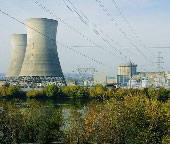 |
While ‘the Mechanism’ is seemingly at work, the prime minister has struck a lyrical note. He is in raptures over the nuclear renaissance that is a-coming; he would dearly love his countrymen to partake of its fruits.
Is it not however an extraordinary sort of renaissance the prime minister is talking of? The mother country for both fundamental and applied nuclear research is the United States of America. Those at the helm of affairs in that country are desperately anxious to discover a major alternative source of energy, since the doings of Osama bin Laden and Hugo Chavez have cast a shadow on their hitherto held assumption of an unending supply of oil. And yet, hardly any enthusiasm is discernible in the US for making nuclear energy the centrepiece of energy expansion programmes. On the contrary, for more than a decade now, there is a total moratorium on setting up new nuclear power plants there. Even with its best endeavours, the American nuclear lobby has failed to convince either economists or the lay public that the unit cost of nuclear power generation compares favourably with that of power generated from thermal or hydroelelectric sources. While controversy over the economic issue was still raging, environmental groups arrived on the scene, effectively cooking the goose for votaries of nuclear power. The frenzy of protests against the perils of nationwide nuclear pollution reached fever pitch; politicians got the message.
Robert Bruce-like characters nonetheless continue to proliferate. Besides, the American military-industrial complex has its own economic calculations to ponder. Having already invested hundreds of billions of dollars in setting up technological capability to build nuclear power plants, it is most keen to find a solution to the problem of surplus capacity in nuclear power-plant building brought about by the large-scale domestic disenchantment with nuclear power. The plan it has worked out neatly dovetails into official American global strategy. The enforcement of nuclear non-proliferation is a handy weapon to maintain American nuclear hegemony. But why not supplement that policy with a further stratagem? Vulnerable countries around the world could be offered, under strictest safeguards, driblets of nuclear fuel and technology for civilian use. In return, these countries could be cajoled to agree, either tacitly or openly, to submerge their separate, sovereign identities into the American imperium.
Several birds are being sought to be killed with one stone. The retention of the US’s near-monopoly over nuclear power is to be accompanied by a steady widening of the country’s colonial ambit. The military-industrial complex will offload some of its excess capacity in the nuclear power plant sector. The strategy fits in with the objective underlying a model of global economic optimum worked out by a group of neo-liberal American economists. The global economy, the model claims, is the net gainer if pollution-creating industries, such as nuclear power plants, are shifted out of the rich countries and relocated in poor underdeveloped lands; since the productivity of an average citizen in a poor country is way below that of an average citizen in prosperous countries, such a shift optimizes global economic welfare. Whether citizens of poor countries might have a point of view in the matter is a query considered too silly to respond to.
The hunt is now on for some suckers who could be enticed into the nuclear power mesh. While Foggy Bottom is assiduously at work to locate strategic allies, it has its silent partners among the transnational corporations like Areva, General Electric, Westinghouse and Toshiba. The stakes for these corporate entities are indeed enormous. Once the 123 Agreement is sealed, apart from roughly $14 billion worth of orders immediately flowing towards their direction, sales of nuclear reactors and technology, estimates suggest, are likely to amount to more than $150 billion over the next two decades. Further benefits to accrue include Indian defence purchase from American firms of more than $70 billion in the course of the next five years. Also to be taken into consideration is the probability of increased business from India on space-related projects, including satellite fabrication and space launches.
The advantages for the US stemming from the nuclear deal are glaringly obvious. How does the picture look from the Indian perspective though? Thanks to the 123 Agreement, our overall capacity for nuclear power generation, the nation is being told, will jump from the present level of 3,300 megawatts to 40,000 MW in 2025. The latter figure will however still be less than 7 per cent of our aggregate requirement of power in that year. Given the prospect of our shrinking coal reserves, we should not, it is argued, be nitpickers and accept whatever the Americans are offering. It is, however, equally possible to come back with the riposte that a red herring is just that, the problem of exhaustible resources is not specific either to coal or to India.
That apart, in India too, nuclear power production is difficult to justify on strict economic grounds. Scores of research works over the past half-a-century have categorically established the point: the unit cost of nuclear power production is double — or even triple — of that of power generated from thermal or hydel sources. A paper by M.V. Ramana in the August 25 issue of the Economic and Political Weekly is even more revealing: the economics of nuclear power generation is so disastrously unfavourable that heavy budgetary subsidies would be needed to sell such power. As far as the phenomenon of pollution is concerned, should not the model set up by American neo-liberal economists send shivers down our spine?
The issue of political sovereignty must of course supersede all else while appraising the worthwhileness of the agreement. Even so, it is intriguing that there are so few discussions in the country on its economic and environmental aspects. On the other hand, efforts to sway public opinion in favour of the 123 Agreement and to paint those who oppose it as shortsighted bigots or worse are intense. One reason for this state of affairs could be the mood of the emerging middle class; having tested the sweet bud of globalization, its members would not mind surrendering, wholesale, to the allure of the great bliss the US is promising.
But might not there be another factor at work? One is suddenly reminded of the furore which took place 13 years ago over the installation of a thermal power plant in Maharashtra by the American conglomerate, the Enron Corporation. By all possible economic criteria, offers by domestic power plant producing units such as the Bharat Heavy Electrical Limited were superior to the offer made by Enron. Politicians in power explained to the Indian public that, never mind the cost calculations, once Enron was allowed to install the plant, it would usher in a cultural revolution in thermal power technology in the country. The sequel is well known. Within three years, the Enron Corporation was exposed as a crooks’ opera, the plant was abandoned and the government had to dole out thousands and thousands of dollars against guarantees and counter-guarantees. Enron’s accounts later revealed that it had spent substantial sums to ‘educate’ Indian public personalities on the merits of its plant: have your own interpretation what this implied.
The prime minister’s renaissance is, in terms of magnitude, far greater than the cultural revolution Enron promised. The 123 Agreement is formally being sponsored by the US administration, which has commandeered its formidable persuasive powers to influence opinion at different political levels in India. Will it be far-fetched to imagine that, complementing official efforts, other initiatives are not lacking either, that behind the veil of a renaissance, a vast ‘educational’ programme has also ensued?










